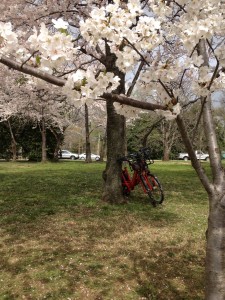Nurturing the bike movement’s budding branches at the National Bike Summit
By Alison Graves, Executive Director
 The time had come for blooming at the National Bike Summit this year. For the first time since I’ve attended the annual gathering, the cherry boughs throughout the district were heavy with light pink fragrant flowers. Also for the first time since I’ve been attending, a new branch of the bicycle-friendly movement, long unrecognized, came bursting back onto the scene, all bright and full of promise. As part of the burgeoning Community Bike Shops network, I am proud and excited at our newfound energy to strengthen our collective voice and be recognized nationally for our unique and important contributions to building healthier, more connected communities with bicycles. Part of what is so unique about our work is the many ways in which we reach new audiences. Whether it’s through youth employment, volunteer engagement, women-specific programming, Major Taylor Clubs, or community collaborations, we build the human infrastructure of bicycling. With the groundwork that has been laid by the movement to date, the opportunities for it to evolve are only limited by our capacity to nurture bicycling’s budding branches.
The time had come for blooming at the National Bike Summit this year. For the first time since I’ve attended the annual gathering, the cherry boughs throughout the district were heavy with light pink fragrant flowers. Also for the first time since I’ve been attending, a new branch of the bicycle-friendly movement, long unrecognized, came bursting back onto the scene, all bright and full of promise. As part of the burgeoning Community Bike Shops network, I am proud and excited at our newfound energy to strengthen our collective voice and be recognized nationally for our unique and important contributions to building healthier, more connected communities with bicycles. Part of what is so unique about our work is the many ways in which we reach new audiences. Whether it’s through youth employment, volunteer engagement, women-specific programming, Major Taylor Clubs, or community collaborations, we build the human infrastructure of bicycling. With the groundwork that has been laid by the movement to date, the opportunities for it to evolve are only limited by our capacity to nurture bicycling’s budding branches.
There were five notable components of the National Bike Summit. As a representative of a small nonprofit it is sometimes difficult to feel like our work matters in the larger context of bicycle advocacy, but the Community Cycling Center’s recent efforts to create community collaborations, engage and showcase new voices in bicycling, and focus on community health and economic development are gaining national recognition and traction.
1: The movement is adapting to changing conditions by exploring unification between the League of American Bicyclists, Bikes Belong, and the Alliance for Biking and Walking. While the process is in its early stages, the idea of grafting these groups holds the promise of a stronger, more resilient organization. As a League board member, I am personally optimistic about this next step and volunteered to chair the League’s new committee to broaden the movement, which would serve the unified organization. The committee will bring together diverse stakeholders, set goals and collect information about programs, projects, and people that reach women, youth, people of color, differently abled and low-income populations through bicycling. This reflects our recent work that we are pursuing with collaborations at Hacienda and New Columbia.
2: The movement is recognizing emergent opportunities by including new voices, such as Maryland Representative Donna Edwards, who spoke at the event’s kickoff. Congresswoman Edwards is the first African American woman representative for Maryland and sits on the Committee on Transportation and Infrastructure. Most notably, she has a personal perspective on the importance of ensuring that bicycles have a place in transportation planning. As a young mother, she relied on a combination of bus and bicycle to get to work. People in every city have similar stories about affordable transportation, but their needs are not as widely known or told. We joined the Transportation Health Equity Network and are working to strengthen both the connections between modes of travel and the advocacy around maintaining strong systems.
3: The movement is recognizing the benefit of cross-fertilization. My favorite breakout session was by New York City’s Local Spokes collaboration. Comprised of nine organizations, ranging from bicycle advocates to community organizers, the group conducted community planning sessions that focused on the needs and interests of communities of color. In the process, the bicycle organizations and the community organizations were transformed. Each developed new relationships and perspectives while achieving more than they could do alone. This work is very similar to our community collaborations. Local Spokes even conducted a needs assessment similar to our Understanding Barriers work.
4: The movement is tending to new growth by supporting the newly formed Community Bicycle Shop network. There are more than 300 organizations like the Community Cycling Center around the country. Collectively, we make bikes affordable, promote bike safety, build community, and reach new audiences. The Alliance for Biking and Walking has stepped up to establish a formal network where we can document our collective impact, share best practices, and strategize how to broaden the movement.
5: Throughout the conference there was so much appreciation for everyone’s contributions. We’re all in this together and as we strengthen relationships and further clarify our roles, the movement will become stronger and reach its goals. As we have learned, it’s all about relationships. As they grow and we learn about interests and opportunities, we are better prepared to make connections and strategic improvements in our community.
It will take some time for all of these components to bear fruit, but in time it will be sweet.